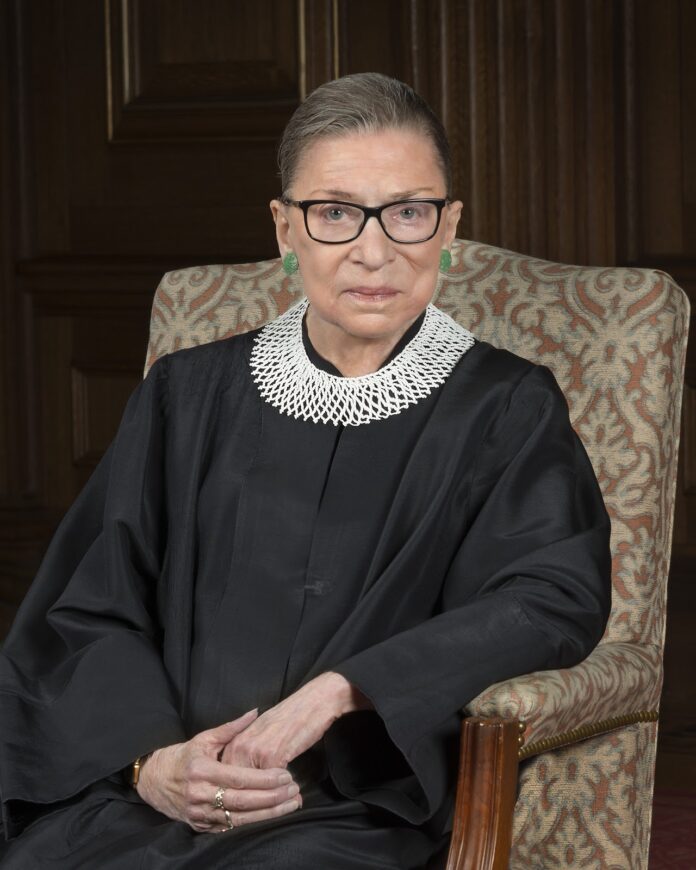By Emma Kelsall
September 18, 2020: a day that marked a significant loss in the fight for equal rights. The passing of Supreme Court Justice Ruth Bader Ginsburg.
Ginsburg was an inspiration to many, and all will miss her. The news of her passing saddened even President Donald Trump. But Ginsburg died a part of history, and her memory will continue to live on. Future generations will educate their children about her fight, her courage, and her intelligence.
Joan Ruth Bader was born on March 15, 1933, in Brooklyn, New York, to Celia and Nathan Bader. Nathan was a Jewish immigrant from Ukraine, and Celia was born in New York to Polish parents. Upon discovering that many other girls in her class were named Joan, Ginsburg decided to go by Ruth to avoid confusion.
Celia actively encouraged her daughter’s education, often taking Ginsburg on trips to the library. Celia was an excellent student in her youth and graduated from high school at age 15. However, her family only had enough money to send her brother to college. Sadly, Celia died of cancer the day before Ginsburg’s high school graduation.
Ginsburg attended Cornell University, where she met Martin D. Ginsburg. She graduated from Cornell with a bachelor of arts degree in government. She received the accolade of being the highest-ranking female in her graduating class.
About a month after her graduation, she and Martin wed and moved to Fort Sill, Oklahoma, where the U.S. Army stationed Martin as a Reserve Officers’ Training Corps. Here, she gave birth to a daughter in 1955.
In 1956, Ginsburg enrolled at Harvard Law School, one of nine women in a class of around 500 men. Despite her academic talent, Ginsburg faced many challenges at Harvard because of her gender. One incident involved the dean of Harvard Law inviting Ginsburg and the eight other women in her class to his house for dinner. Here he asked them, “Why are you at Harvard Law School, taking the place of a man?”
When Martin took a job in New York City, Ginsburg transferred to Columbia Law School. She became the first woman to be on two major law reviews: the Harvard Law Review and the Columbia Law Review. Ginsburg graduated from Columbia in 1959 with a law degree and tied for first in her class.
Despite her achievements, in her early career, Ginsburg struggled to find employment. In 1960, Supreme Court Judge Felix Frankfurter rejected Ginsburg for a clerkship position because of her gender. Columbia Law Professor Gerald Gunther pushed for Judge Edmund L. Palmieri to hire Ginsburg as a clerk at the U.S. District Court for the Southern District of New York. After Gunther threatened never to recommend another Columbia student to Palmieri if he did not hire Ginsburg, she began her clerkship with Palmieri.
Ginsburg’s first position as a professor was at Rutgers Law School in 1963; however, she was informed she would be paid less than her male counterparts, as she had a husband with a well-paying job. At the time, she was one of 25 female law professors in the United States. After co-founding the Women’s Rights Law Reporter, the first law journal in the United States to focus exclusively on women’s rights, she began to teach at Columbia Law School. Here, she became the first tenured woman and co-authored the first law school casebook on sex discrimination.
When Congress passed the Omnibus Judgeship Act of 1978, increasing the number of federal judges in district courts by 117 and 35 in circuit courts, President Jimmy Carter ensured the law emphasized that appointed judges included women and minorities. In January 1979, Ginsburg filled out the questionnaire for possible nominees to the Court of appeals for the District of Columbia Circuit. President Carter nominated her to a seat on the D.C. Circuit appeals court. She received her commission on June 18, 1980.
Ginsburg was nominated as an Associate Justice of the Supreme Court by President Bill Clinton on June 22, 1993. At the time of her nomination, Ginsburg was seen as a moderate and consensus builder from her time in the Court of appeals. Clinton was reportedly seeking to increase the Court’s diversity. Ginsburg became the first Jewish Justice since 1969 and the second woman on the Supreme Court when she was sworn in on August 10, 1993.
During her time on the Supreme Court, Ginsburg addressed many hot topics: gender discrimination, abortion rights, search and seizure, international law, voting rights, affirmative action, and Native American rights. She showed an extraordinary passion for her position and used it to further the fight for equality. Even when Ginsburg was diagnosed with colon cancer in 1999, she did not miss a day on the bench.
Sadly, Ginsburg passed away from pancreatic cancer. But while she may no longer be with us, her legacy will live on.










